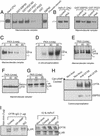A macromolecular complex of beta 2 adrenergic receptor, CFTR, and ezrin/radixin/moesin-binding phosphoprotein 50 is regulated by PKA
- PMID: 12502786
- PMCID: PMC140971
- DOI: 10.1073/pnas.0135434100
A macromolecular complex of beta 2 adrenergic receptor, CFTR, and ezrin/radixin/moesin-binding phosphoprotein 50 is regulated by PKA
Abstract
It has been demonstrated previously that both the cystic fibrosis transmembrane conductance regulator (CFTR) and beta(2) adrenergic receptor (beta(2)AR) can bind ezrinradixinmoesin-binding phosphoprotein 50 (EBP50, also referred to as NHERF) through their PDZ motifs. Here, we show that beta(2) is the major adrenergic receptor isoform expressed in airway epithelia and that it colocalizes with CFTR at the apical membrane. beta(2)AR stimulation increases CFTR activity, in airway epithelial cells, that is glybenclamide sensitive. Deletion of the PDZ motif from CFTR uncouples the channel from the receptor both physically and functionally. This uncoupling is specific to the beta(2)AR receptor and does not affect CFTR coupling to other receptors (e.g., adenosine receptor pathway). Biochemical studies demonstrate the existence of a macromolecular complex involving CFTR-EBP50-beta(2)AR through PDZ-based interactions. Assembly of the complex is regulated by PKA-dependent phosphorylation. Deleting the regulatory domain of CFTR abolishes PKA regulation of complex assembly. This report summarizes a macromolecular signaling complex involving CFTR, the implications of which may be relevant to CFTR-dysfunction diseases.
Figures





Similar articles
-
Stimulation of beta 2-adrenergic receptor increases cystic fibrosis transmembrane conductance regulator expression in human airway epithelial cells through a cAMP/protein kinase A-independent pathway.J Biol Chem. 2003 May 9;278(19):17320-7. doi: 10.1074/jbc.M212227200. Epub 2003 Mar 5. J Biol Chem. 2003. PMID: 12621035
-
Ezrin controls the macromolecular complexes formed between an adapter protein Na+/H+ exchanger regulatory factor and the cystic fibrosis transmembrane conductance regulator.J Biol Chem. 2005 Nov 11;280(45):37634-43. doi: 10.1074/jbc.M502305200. Epub 2005 Aug 28. J Biol Chem. 2005. PMID: 16129695
-
E3KARP mediates the association of ezrin and protein kinase A with the cystic fibrosis transmembrane conductance regulator in airway cells.J Biol Chem. 2000 Sep 22;275(38):29539-46. doi: 10.1074/jbc.M004961200. J Biol Chem. 2000. PMID: 10893422
-
CFTR-NHERF2-LPA₂ Complex in the Airway and Gut Epithelia.Int J Mol Sci. 2017 Sep 4;18(9):1896. doi: 10.3390/ijms18091896. Int J Mol Sci. 2017. PMID: 28869532 Free PMC article. Review.
-
Influence of phosphorylation by protein kinase A on CFTR at the cell surface and endoplasmic reticulum.Biochim Biophys Acta. 1999 Dec 6;1461(2):275-83. doi: 10.1016/s0005-2736(99)00163-7. Biochim Biophys Acta. 1999. PMID: 10581361 Review.
Cited by
-
Roflumilast combined with adenosine increases mucosal hydration in human airway epithelial cultures after cigarette smoke exposure.Am J Physiol Lung Cell Mol Physiol. 2015 May 15;308(10):L1068-77. doi: 10.1152/ajplung.00395.2014. Epub 2015 Mar 20. Am J Physiol Lung Cell Mol Physiol. 2015. PMID: 25795727 Free PMC article.
-
Current insights into the role of PKA phosphorylation in CFTR channel activity and the pharmacological rescue of cystic fibrosis disease-causing mutants.Cell Mol Life Sci. 2017 Jan;74(1):57-66. doi: 10.1007/s00018-016-2388-6. Epub 2016 Oct 8. Cell Mol Life Sci. 2017. PMID: 27722768 Free PMC article. Review.
-
A Neutralizing Aptamer to TGFBR2 and miR-145 Antagonism Rescue Cigarette Smoke- and TGF-β-Mediated CFTR Expression.Mol Ther. 2019 Feb 6;27(2):442-455. doi: 10.1016/j.ymthe.2018.11.017. Epub 2018 Dec 6. Mol Ther. 2019. PMID: 30595527 Free PMC article.
-
Protein-protein interactions at the adrenergic receptors.Curr Drug Targets. 2012 Jan;13(1):15-27. doi: 10.2174/138945012798868489. Curr Drug Targets. 2012. PMID: 21777184 Free PMC article. Review.
-
Functional Consequences of CFTR Interactions in Cystic Fibrosis.Int J Mol Sci. 2024 Mar 16;25(6):3384. doi: 10.3390/ijms25063384. Int J Mol Sci. 2024. PMID: 38542363 Free PMC article. Review.
References
-
- Welsh M J, Tsui L-C, Boat T F, Beaudet A L. In: The Metabolic and Molecular Basis of Inherited Diseases: Membrane Transport Systems. Scriver C, Beaudet A L, Sly W S, Valle D, editors. Vol. 3. New York: McGraw–Hill; 1995. pp. 3799–3876.
-
- Gadsby D C, Nairn A C. Adv Second Messenger Phosphoprotein Res. 1999;33:79–106. - PubMed
-
- Kunzelmann K. News Physiol Sci. 2001;16:167–170. - PubMed
Publication types
MeSH terms
Substances
Grants and funding
LinkOut - more resources
Full Text Sources
Other Literature Sources
Research Materials
Miscellaneous

